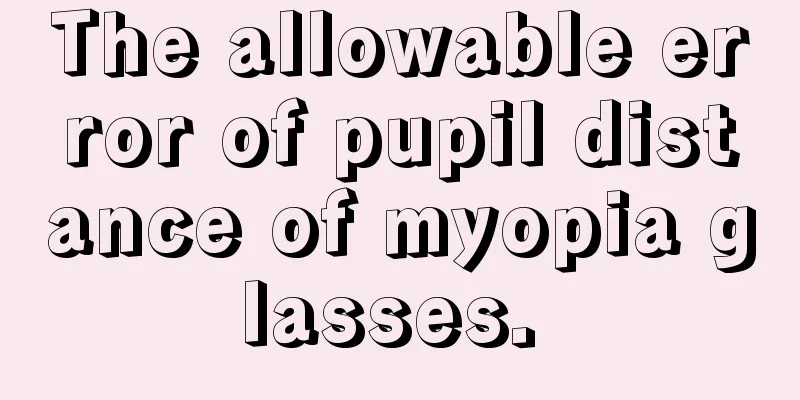The allowable error of pupil distance of myopia glasses.

|
Nowadays, more and more people have to wear myopia glasses due to declining eyesight. In fact, wearing myopia glasses is a little painful. But in order to study and work normally, I have to do this. Most people still choose traditional glasses. Because traditional lens glasses are very convenient to wear, you can just pick them up and go. Because glasses are directly linked to vision. So we can no longer be careless when wearing glasses. Choosing a pair of suitable glasses is particularly important. We not only need to choose lenses with appropriate degrees. When making glasses, the appropriate pupil distance must also be considered. So what is the allowable error for appropriate pupil distance? Pupillary distance In short, the pupil distance is the distance between the pupils. When a normal person looks at the same object with both eyes, images of the object are formed on the retinas of both eyes and overlap in the visual center of the brain to become a complete, three-dimensional single object. This function is called binocular single vision. However, infants and young children are easily affected by external factors during the process of developing binocular single vision, causing one eye to focus on a target while the other eye deviates and cannot look at the same target, thus resulting in strabismus. In medicine, the condition of the eyes looking inward when looking at an object is called esotropia, which is commonly known as "cross-eyed". Routine measurement steps for far pupil distance ⑴ The examiner and the patient should sit face to face with a distance of 40 cm between them, so that their eyes are at the same height. ⑵ The examiner holds the interpupillary distance ruler or ruler with the thumb and index finger of his right hand, and the other fingers rest on the patient's cheek. Then the interpupillary distance ruler is placed at the lowest point of the bridge of the nose and slightly tilted along the angle of the bridge of the nose. ⑶ The examiner closes his right eye and asks the patient to look at the examiner's left eye with his right eye. When the examiner looks at the patient's right eye with his left eye, he aligns the "zero position" of the interpupillary distance ruler with the pupil center of the patient's right eye. (4) The examiner opens his right eye and closes his left eye, and asks the patient to look at his right eye with his left eye. When the examiner looks at the patient's left eye with his right eye, he accurately reads the value of the pupil distance ruler at the center of the patient's left pupil. ⑸ The examiner repeats step ⑶ to confirm whether the "zero position" of the pupil distance ruler is aligned with the center of the patient's right pupil. If it is correct, the value read in step (4) is the patient's pupil distance. Near measurement ⑴ The examiner and the patient should sit face to face with a distance of 40 cm between them, so that their eyes are at the same height. ⑵ The examiner holds the interpupillary distance ruler or ruler with the thumb and index finger of his right hand, and the other fingers rest on the patient's cheek. Then the interpupillary distance ruler is placed at the lowest point of the bridge of the nose and slightly tilted along the angle of the bridge of the nose. ⑶ The examiner closes his right eye and asks the patient to look at his left eye with both eyes, and uses his left eye to align the "zero position" of the interpupillary distance ruler with the pupil center of the patient's right eye. (4) The examiner opens his right eye and asks the patient to continue looking at his left eye, and uses his right eye to read the value at the center of the patient's left pupil. ⑸ Repeat steps ⑶~⑷ three times and take the average value as the near pupil distance. According to national standards, the pupil distance error within 150 degrees cannot exceed ±4mm; the pupil distance error within 250 degrees cannot exceed ±3mm; and the pupil distance error above 250 degrees cannot exceed ±2mm. In addition, the pupil distance error of myopic glasses should be larger rather than smaller. 2mm larger is better than 2mm smaller. However, if your eyes are not very sensitive, there is no problem! |
<<: Negative oxygen ion glasses
Recommend
How often should women change their underwear?
Women's underwear is a very close-fitting gar...
How to treat cold and numb legs and feet
Many people easily feel cold hands and feet due t...
What is the best way to prevent tracheitis?
Many patients who like to smoke often suffer from...
Black tea dregs are a "nourishment" treasure
The uses of black tea dregs. Black tea dregs are ...
What are the nursing measures for bone cancer
What are the nursing measures for bone cancer? Wh...
What are the steps for cervical cancer screening
Cervical cancer screening usually includes the fo...
What is the normal ratio of albumin to globulin
The structure of the human body is very complex. ...
Can leg raises help slim down your legs?
Leg raising is an exercise that targets the knee ...
After suffering from laryngeal cancer, you should be prepared for laryngeal cancer treatment
After suffering from laryngeal cancer, you should...
What are the methods to clean clogged pores
We all hope that our skin is smooth, white and el...
Can spinal cord injury be cured?
With the improvement of people's living stand...
Things to note about axillary lymphoma
Lymphoma is the most serious disease of the lymph...
Can prostate cancer be inherited?
Many people want to know whether prostatitis is h...
What are the dangers of having a full-cut double eyelid?
Double eyelids are a very popular eye shape in li...
Ten things to note when wearing crystals to achieve superimposed effects
In life, many girls have the habit of wearing cry...









